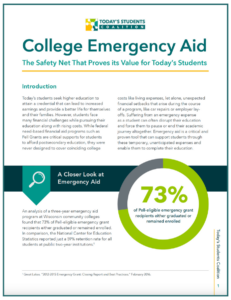Emergency Aid Policy Brief
 Today’s students pursuing higher education face many financial challenges in addition to rising college costs. Federal need-based financial aid programs were never designed to cover coinciding education costs, let alone unexpected financial setbacks that arise during the course of a program, like car repairs or employer layoffs. Emergency aid is a critical and proven tool that can support students through these temporary, unanticipated expenses and enable them to complete their education.
Today’s students pursuing higher education face many financial challenges in addition to rising college costs. Federal need-based financial aid programs were never designed to cover coinciding education costs, let alone unexpected financial setbacks that arise during the course of a program, like car repairs or employer layoffs. Emergency aid is a critical and proven tool that can support students through these temporary, unanticipated expenses and enable them to complete their education.
The Higher Education Emergency Relief Fund (HEERF) emerged during the coronavirus pandemic, providing $77 billion to institutions of higher education (IHEs) with 50% designated to emergency financial aid grants to students. The grants assisted millions of students throughout the national emergency, allowing many to continue their education and navigate the financial shock of the pandemic.
When a Little Help Goes a Long Way
Today’s Students Coalition College Emergency Aid policy brief takes a closer look at the influence of emergency aid on college retention rates and examines:
- institution-level emergency aid
- an emergency aid experiment that proved its own worth
- lessons learned from HEERF
- A permanent emergency aid for today’s students
![]()
A strong federal investment in an emergency aid program informed by the lessons learned from pandemic higher education relief funds that helped millions of students stay enrolled proves how a little help goes a long way in supporting the needs of today’s students.
— TSC Emergency Aid Brief
